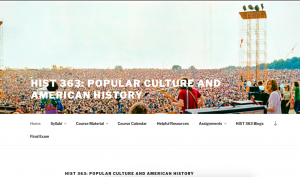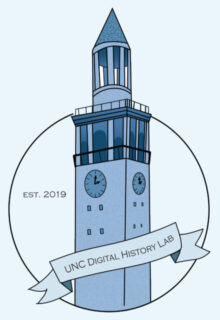When universities across the country announced that classes would be moving online back in March, I hopped on Twitter and saw the social media equivalent of Hellmo.

Understandably, faculty and graduate students were equal parts anxious, furious, and saddened by the fact that the spring 2020 term had been turned on its head. This was my response too, at first, but then I was overcome by a sense of calm.
Because my class was already partially online.
I designed my spring class, “Popular Culture and American History,” as a “hybrid” course. My students and I met three times a week in person, but we also had a sense of community online. When planning the class, I wanted to create an online hub for my students. In the past, I’ve found students to be not just able but also eager to use digital tools beyond the typical Learning Management System (in UNC’s case, Sakai, which I find to be a bit clunky). So I did what any good teacher would do: I cribbed something from someone else’s syllabus.
When I was an undergraduate student at the University of Central Arkansas, I took a class on Film and American History, taught by Dr. David Welky. We all created blogs using WordPress and wrote weekly posts about course material. I liked the blog format for a couple of reasons: first of all, it let me speak at length about my interests in film to a (literally) captive audience. More importantly, it gave me—a generally reticent and reserved student who preferred to show my grasp of the material in writing—an opportunity to engage with my classmates and course material beyond raising my hand to speak in class.

I adapted this idea for my own class and expanded it to make students’ blogs (and my own) a digital version of our in-person class. Students created their blogs using UNC’s WEBdotUNC platform, which allows any UNC affiliate to create up to five websites using WordPress. I placed students in groups of four to five people and, every week, students wrote at least one post on their blog and commented on their group mates’ posts.
Usually the blog post prompts asked students to bring together material from lectures and supplementary material. But some weeks were “free post” weeks, where students could explore any topic of their choosing, as long as it related to course material. As a class about pop culture, these free posts allowed students to take the kinds of analysis we did in class and in regular blog posts and apply them to something they were personally interested in. Students wrote about Stephen King and suburban anxiety, gendered analyses of the anti-disco backlash, and many other topics, allowing them to teach each other about topics we didn’t get to cover in class and that they were personally enthusiastic about. Moreover, it gave me an opportunity to learn from my students more than I ever had before and to see popular culture through their diverse experiences and interests.
We posted other assignments on our blogs—one of which I will detail in a future post for THO—but these weekly posts became a digital alternative to, say, recitation sections. They also allowed my students to asynchronously engage with the class as their own schedules and circumstances allowed.
The blog assignment was helpful even before COVID-19, but it made the transition to online instruction easier than it might have been otherwise. My students were already used to having a sense of community with one another online, months before UNC made the shift to remote instruction. I didn’t design this assignment with a global pandemic in mind, but it definitely helped make my class extremely flexible—and it meant that moving class online was a relatively seamless transition for me and my students.
In their final self-assessments, students broadly agreed on the merits of this hybrid approach. One of my students wrote to me that “this was the best way of handling the transition to remote learning that I’ve seen in any of my classes.” Another wrote that “the blog posts are a great idea because they allow autonomy while still providing a way to interact with the course material.” One student admitted that they were “extremely skeptical of the blog post assignment at first,” but “got pretty into it pretty quickly” and “appreciated the creative freedom you gave us, and I think it paid off.” Finally, another student said they were “a little bit worried about how my classes would transition to remote learning, but I think everything in this class has continued pretty similarly to how it was before Spring Break.”
Based on my own experience and feedback from my students, I encourage teachers at all levels to consider making their classrooms be “hybrid” from day one—all the time, not just when a potential second wave is looming. A heavy online presence allowed me to hear from students who I might not hear from in the physical classroom. It fostered a palpable sense of community among my students. Finally, it gave us all a space to gather and converse even when we were sheltering in place hundreds (and in some cases, thousands) of miles apart.
